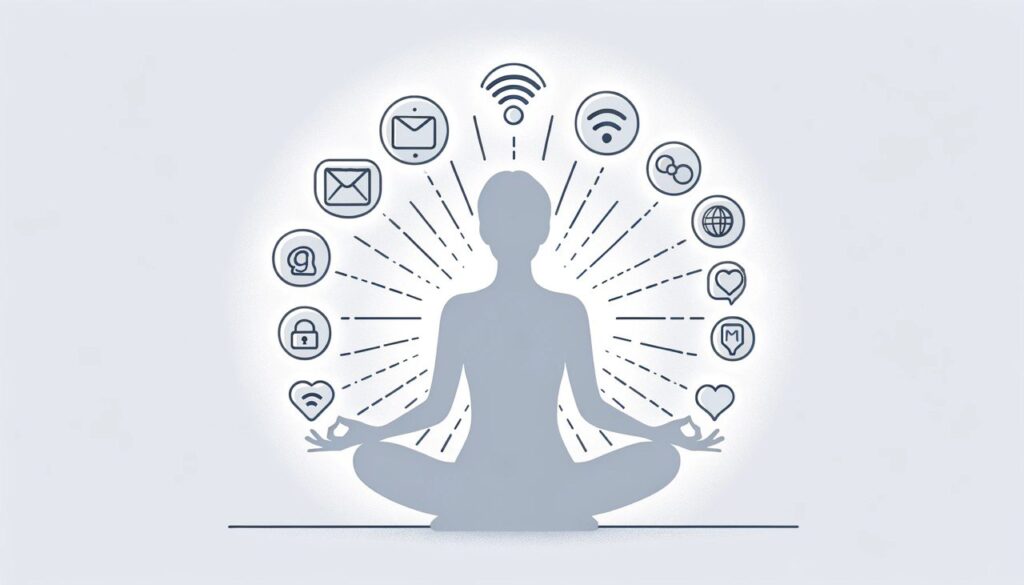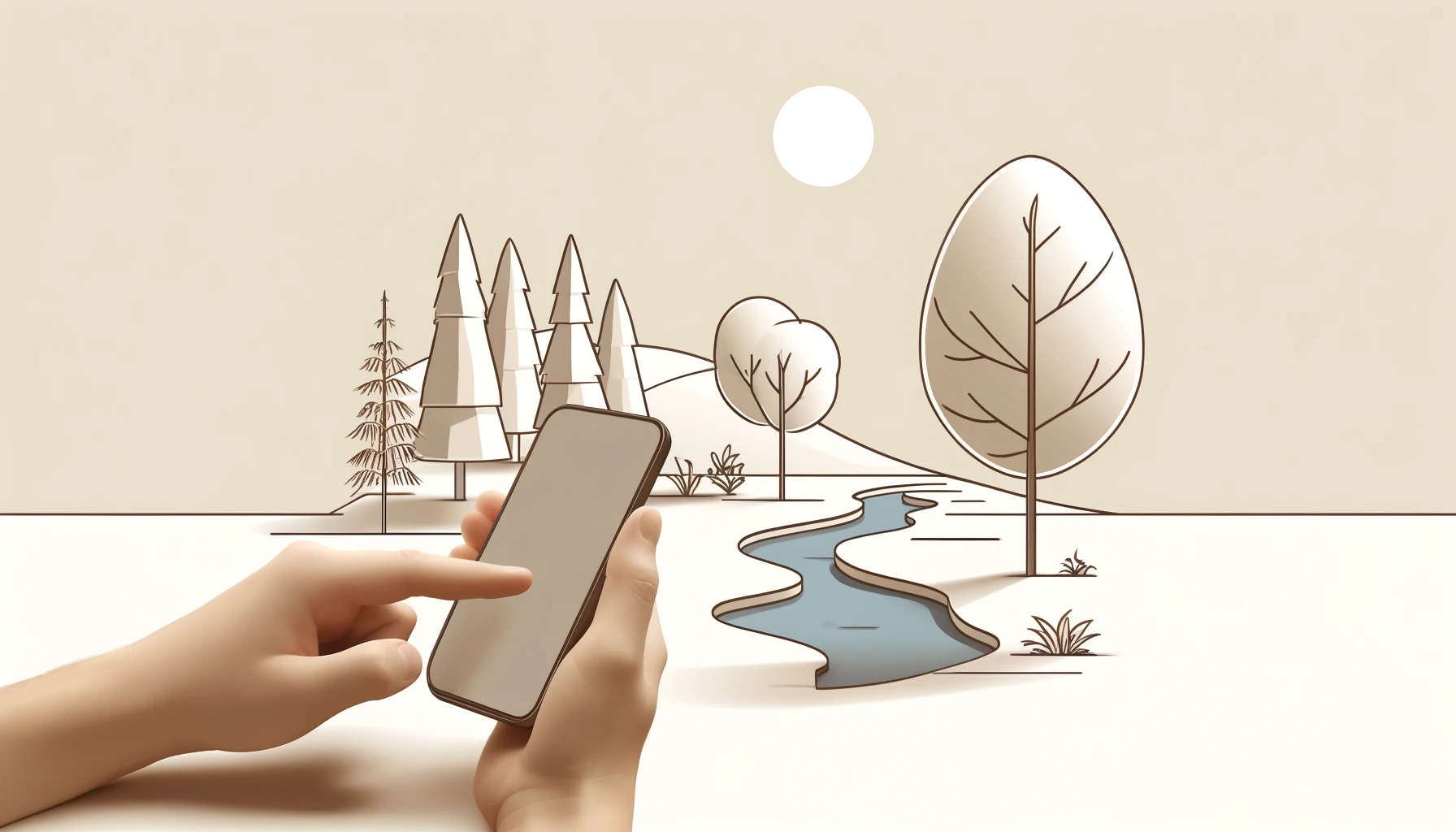Smartphones and social media dominate our lives, and anxiety has become an all-too-common companion. Did you know that constant notifications and information overload can significantly impact your mental health? Research shows a direct link between our digital habits and rising anxiety levels.
However, you’re not alone. Anxiety is on the rise in the digital age, but there are ways to navigate it. Join us as we explore effective, research-backed strategies to navigate anxiety in the digital age. Let’s take the first step towards a calmer, more mindful relationship with technology.
Understanding Digital Age Anxiety
In today’s fast-paced world, digital technology is both a blessing and a curse. We’re always connected, which means we’re always “on.” This constant connectivity can be overwhelming and contribute significantly to our anxiety levels. Let’s break down how:
- Social media: Platforms like Facebook, Instagram, and Twitter are designed to keep us engaged, but they can also lead to feelings of inadequacy, FOMO (fear of missing out), and even social comparison. It’s easy to get caught in a cycle of scrolling and comparing, which can heighten anxiety.
- Constant notifications: Every ping from our phones can trigger a stress response. Whether it’s a new email, a social media update, or a breaking news alert, these constant interruptions can make it hard to focus and create a sense of urgency that leads to anxiety.
- Information overload: We live in an era of information. While access to information is empowering, the sheer volume can be overwhelming. The pressure to stay informed and up-to-date can lead to mental exhaustion and heightened anxiety.
Research Findings on Digital Consumption and Mental Health
Research has shown a strong link between excessive digital consumption and increased anxiety. A study by the University of Pennsylvania found that reducing social media use to 30 minutes a day can significantly reduce anxiety and depression.
Another study by the American Psychological Association highlights that people who check their emails constantly throughout the day report higher stress levels compared to those who set specific times for email checking.
By understanding the ways digital technology affects our mental health, we can start to take steps to mitigate its impact. In the following sections, we’ll explore practical tips and mindfulness practices to help you navigate anxiety in the digital age. Remember, it’s not about eliminating technology from your life but about finding a balance that works for you.

Practical Tips for Managing Digital Anxiety
Navigating anxiety in our digital world can feel daunting, but with some mindful adjustments, you can reclaim your peace. Here are some practical tips to help you manage digital anxiety effectively.
Set Boundaries with Technology
Creating clear boundaries with your digital devices is essential for maintaining mental health. It’s all about finding the right balance that works for you.
- Establish specific times to check emails and social media: Rather than constantly checking your emails or social media feeds throughout the day, designate specific times for these activities. For instance, you might decide to check emails only in the morning and late afternoon.
- Use technology-free zones or times in your day: Dedicate certain areas of your home or specific times of the day as technology-free. For example, you could make your bedroom a tech-free zone to promote better sleep or set aside the first hour after waking up as a screen-free time to start your day more mindfully.
Curate Your Digital Environment
The content you consume online has a significant impact on your mental health. Curating your digital environment can help reduce anxiety and promote a more positive online experience.
- Unfollow or mute accounts that trigger anxiety: Take a moment to evaluate the accounts you follow on social media. If certain accounts consistently make you feel anxious or inadequate, consider unfollowing or muting them. Your mental health is more important than staying updated with every post.
- Follow accounts that promote positivity and mindfulness: Seek out and follow accounts that inspire you, promote positivity, and encourage mindfulness. This can help create a more uplifting and supportive online environment, reducing the likelihood of anxiety triggers.
Limit Notifications
Notifications can be one of the biggest sources of anxiety in the digital age. By managing and limiting them, you can create a calmer and more focused environment.
- Turn off non-essential notifications: Go through your phone settings and turn off notifications for non-essential apps. Do you really need to know every time someone likes your photo or a new video is uploaded? Probably not. Limiting these notifications can reduce the feeling of being constantly “on call.”
- Use ‘do not disturb’ mode during focus periods: When you need to concentrate on a task, enable the ‘Do Not Disturb’ mode on your devices. This helps create a distraction-free environment, allowing you to focus better and reduce stress.
Implementing these practical tips can significantly improve your management of digital anxiety. By setting boundaries, curating your digital environment, and limiting notifications, you can take control of your digital life and create a more mindful and peaceful relationship with technology.
Mindfulness Practices to Combat Digital Anxiety
Incorporating mindfulness practices into your daily routine can be incredibly effective in managing digital anxiety. These practices help ground you, bring you back to the present moment, and foster a healthier relationship with technology.
Mindful Breathing
When anxiety starts to creep in, mindful breathing can be a powerful tool to bring yourself back to a state of calm. It’s simple, quick, and can be done anywhere.
Simple Breathing Exercises to Ground Yourself
When you feel overwhelmed by digital stress, take a moment to focus on your breath. Close your eyes, take a deep breath in through your nose, hold it for a few seconds, and then slowly exhale through your mouth. Repeat this a few times until you feel more centered.
4-7-8 Breathing Technique
This specific breathing exercise can be particularly calming. Inhale quietly through your nose for 4 seconds, hold your breath for 7 seconds, and exhale completely through your mouth for 8 seconds. This technique can help reduce immediate feelings of anxiety and create a sense of relaxation.
Digital Detox
Taking regular breaks from screens can significantly reduce digital anxiety and improve your overall well-being. Planning a digital detox doesn’t have to be complicated, and the benefits can be profound.
Plan regular breaks from screens. Schedule specific times during your day or week to step away from all screens. Even short breaks can help reduce eye strain, mental fatigue, and anxiety.
Suggestions for activities during a digital detox:
- Nature walks: Spend time outdoors, enjoy the fresh air, and connect with nature. This can be incredibly rejuvenating.
- Reading: Pick up a physical book or magazine and get lost in a good story or learn something new.
- Hobbies: Engage in a favorite hobby or try something new, like painting, cooking, or gardening. These activities can provide a much-needed break from digital devices and foster creativity and relaxation.
Mindful Consumption
Being mindful of how you consume digital content can transform your relationship with technology. It’s about being present and intentional with your digital interactions.
- Practice being present while consuming digital content: When you are online, try to be fully present. Notice how you feel, what you are thinking, and how your body is reacting. Are you feeling tense or relaxed? Being aware of these responses can help you make more mindful choices about your digital consumption.
- Set intentions before engaging with digital devices: Before you pick up your phone or open your laptop, take a moment to set an intention. Are you checking emails for work, connecting with friends, or simply passing time? Being clear about your purpose can help you stay focused and avoid mindless scrolling.
Incorporating these mindfulness practices into your routine can significantly reduce digital anxiety.
Research-Based Practices
Engaging in physical activity and ensuring quality sleep are two research-backed practices that can significantly help manage digital anxiety.
Exercise and Physical Activity
Physical activity is a proven method to reduce anxiety. Exercise releases endorphins, which are natural mood lifters. Incorporating short, mindful exercises throughout your day, such as a quick walk, stretching, or yoga, can make a big difference. Even a few minutes of movement can help clear your mind and reduce stress levels.
Quality Sleep
The relationship between screen time and sleep quality is well-documented. Excessive screen time, especially before bed, can disrupt sleep patterns and lead to increased anxiety. Improving sleep hygiene is essential.
Establish a screen-free time at least an hour before bed and create a relaxing bedtime routine. This might include reading a book, practicing gentle stretches, or listening to calming music. Ensuring a good night’s sleep can significantly reduce anxiety and improve overall well-being.

Taking Control of Your Digital Life
Managing digital anxiety is all about balance and mindfulness. You can reduce anxiety and enhance your well-being by setting boundaries with technology, curating your digital environment, incorporating mindfulness practices, and following research-based strategies.
Remember, the goal is not to eliminate technology but to use it mindfully and intentionally. Start with small changes and observe how they positively impact your mental health. Embrace a balanced approach to your digital life, and take control of your anxiety, one mindful step at a time.

Leave a Reply